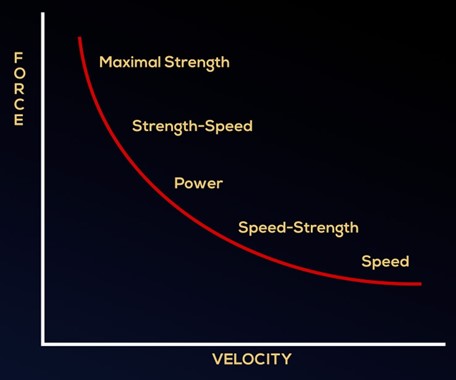The power testing for proteus motion is designed to measure power output for all the major areas of the body necessary for athletic performance. After completing the power test, a report is generated and organized to show the athletes ability to generate power and acceleration for each movement pattern. If power levels are higher than acceleration, then you should consider working on speed-strength activities to improve overall explosiveness (light resistance). If acceleration levels are higher than power, then you should consider working on strength-speed activities to improve overall power (heavy resistance).
Below are the 7 performance tests we utilize to test athletes ability to generate power and acceleration. The tests allow us to evaluate numerous physical qualities including pushing, pulling, lower body vertical and lateral power/acceleration, and rotational power and acceleration outputs. Among other things, the tests allow us determine the difference in their ability to generate power and acceleration, look at range of motion, asymmetry comparing both sides, and Each test is performed for 5 reps on each side with maximal power output.
- Horizontal Row/Press
- PNF D2 Diagonal Flexion/Extension
- Plyometric Trunk Rotation Non-Counter Movement
- Plyometric Trunk Rotation Counter-Movement
- Full Body Rotational Shotput
- Lateral Jump
- Vertical Jump
The data and information we gather about the athletes’ performance tests allows us to ask the following questions to determine the proper course of action we need to take to enhance performance.
1. Where are athletes on the speed-strength continuum?

2. What are their strengths and weaknesses?
3. Where are they more powerful?
4. Where do they lack power?
5. Are they deficient in force or velocity?
6. Force Velocity Curve- Where is the athlete on the curve?

To understand the difference between power and acceleration, it’s important to define and understand them. Power= Force x Velocity. In order for an athlete to be powerful, they need to be strong, and they need to express that strength in an explosive manner to maximize power output. Power is simply an expression of how fast an athlete can move an object at any particular resistance. Acceleration is an expression of how quickly they can achieve peak velocity. What is their peak velocity at any particular resistance using the proteus.
An analogy I like to give is this. Take a mack truck and a Ferrari. They can both get up to 100 MPH. Which one is going to get to 100 MPH faster? The obvious answer is the Ferrari. We want our athletes to be like the Ferrari because the Ferrari can accelerate faster than the Mack truck to achieve peak velocity at 100 MPH.
When we break down the data and information on the power tests, we like to compare and contrast it to specific baseball metrics such as hitting and throwing velocities. We know and understand that power is plane specific and we need to train in specific planes that replicate the speeds and movement partners we are going to encounter on the playing field. When we look at the trunk rotation and full body rational shotput tests, we can compare the power and acceleration outputs to throwing and hitting velocities and observe that the athletes with the highest test scores on the proteus tests will also demonstrate the highest scores on the baseball tests. This information reinforces a lot of what we already know and mentioned above as it relates to testing and training rotational power development. We need to train in rotational planes of movement and replicate speeds to generate higher levels of hitting and throwing velocities.
Acceleration takes place at a specific juncture in time, and that time is when the front foot strikes the ground. Take throwing velocity for example, you can’t generate velocity until the front foot strikes the ground. When the front foot strikes the ground, it’s go time. It’s time to generate velocity as the athlete moves down hill towards the plate.
There are numerous other factors that need to take place to generate velocity as well. Proper kinematic sequencing is a factor of an athlete’s ability to be mobile, stable, have adequate joint range of motion, and be strong, power, and explosive while delivering a pitch. If an athlete has energy leakage throughout their body, they will demonstrate poor kinematic sequencing, ultimately affecting their direction down the mound and their ability to generate velocity.
While the proteus testing is great for showing us in detail where athletes lack in power and acceleration, we still need to see where they are deficient in movement at various other regions of the body. The combination of testing power and acceleration and evaluating movement inefficiencies will allow us to put together the most comprehensive and individualized strength and conditioning plan that addresses the athletes strengths, weaknesses, and deficiencies to move them closer to the next level of performance enhancement and a healthy playing career.


